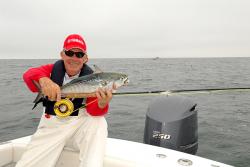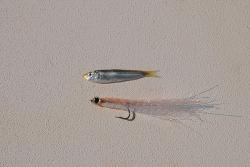Yamaha Fishing Feature: Fall Light-Tackle Brawl
from The Fishing Wire
Inshore anglers along the East Coast, from Florida to New England, look forward to fall for a lot of reasons. But those among us who enjoy a really good fight on very light tackle tend to rejoice more than our brethren. That’s because fall is when one of our favorite adversaries moves inshore, often right along the beach fronts, offering us some fast-and-furious, run-and-gun fishing with the lightest of tackle. It’s albie time!
False albacore, also called little tunny, albies or bonito in southern waters, are one of the smallest of the true tunas. While most encountered inshore are in the three-to-10 pound range, they can grow to weights in excess of 30 pounds. The world record, according to the International Game Fish Association, was caught on the edge of the Continental Shelf in the Washington Canyon, 80 miles off southern Maryland, and tipped the scales at a remarkable 36 pounds! They are relatives of the yellowfin, bigeye and bluefin tuna and when you hook one, you’ll realize they possess the same strength and fighting spirit as their much larger cousins, just on a scaled down level. So the trick to getting the most out of fishing for them is to scale down your tackle, hang on and enjoy the ride.
Albies, fishery biologists tell us, are the most abundant tuna species in the Atlantic where they range throughout temperate and subtropical waters, but if you chase them on a regular basis, you might sometimes question that statistic. At times, they appear to be everywhere at once crashing bait on the surface and at others, they can be almost impossible to find. In U.S. waters, they range as far north as Maine and as far south as the Florida Keys and throughout the Gulf of Mexico. We’ve personally caught them from Narragansett Bay to the Marquesas to the Mississippi Delta, and pretty much everywhere in between!
Albies feed on a wide range of small schooling baitfish including silversides, bay anchovies, sardines, small menhaden and herring. Anything shiny and moving fast with lots of company is a target for these speedy predators. When they key in on large schools of small baitfish they usually travel in wolf packs, so if you find one, you’ve found a lot. How long they stay in one place is always a contributing factor to how many you’ll catch because they tend to move quickly from one school of bait to the next, popping up in a confusion of surface splashes only to disappear almost as quickly as they surfaced. Albies are aggressive when feeding and quick to hit artificial lures, particularly small, shiny metal jigs and flies. What makes them so much fun to catch is their speed and stamina.If fall is albie time in southern New England and the Mid-Atlantic states, then you might guess that they are migratory and you would be correct, although their migratory habits can be difficult to predict from year to year. They tend to spend much of the winter in their southern haunts, and then begin a northward migration that takes them up the Eastern Seaboard where they provide loads of fishing fun for anglers in Northern Florida, Georgia and the Carolinas. But as they move further north, they tend to push well offshore. It is also thought that large schools transit the North Atlantic, but little research has been done to test that theory. By late summer, they will start to move inshore off Massachusetts and Rhode Island where they will hunt bait schools in bays and sounds, around inlets and areas where currents collide. As they begin the fall run southward, they tend to stay closer to shore moving into the Long Island Sound, where they take advantage of massive schools of small baitfish moving out of the many estuaries into the Sound proper.
October, along the eastern end of Long Island, offers some of the best albie fishing to be found anywhere, as millions of bay anchovies in massive schools make their way around the Point at Montauk right into the path and hungry mouths of thousands of albies and small striped bass. They are so close to the beach surf fishermen catch their share standing on the rocks, but boat fishermen really cash in on the fast-paced action.
A little later in October, albies show en mass along the south shore of Long Island and the Jersey Coast. The fishing is different, but can be just as frenetic when a school of albacore finds a school of small baitfish, and there are plenty of those exiting the estuaries in both locales. The parade just keeps happening slowly, moving to the south. At the same time this is all going on, albies show up off Harkers Island, North Carolina, where they do a repeat of performance similar to that in Montauk. By this time, the action takes place around Cape Lookout National Seashore around the southern-most barrier island, Shackleford Banks, and around the inner waters of the island itself. The key to their presence is always the same—massive schools of small baitfish.
Most anglers fish for them with light spinning tackle. A seven-foot light-action spinning rod loaded with six- to 12-pound test line does the trick and makes the fight loads of fun. Hook a big one and you just might find yourself cranking up the outboard to chase it, and to keep from running out of line on the reel. Albies are the ideal inshore fish for challenging with fly tackle. A nice eight- or 10-weight rod matched with a quality reel with a super smooth drag that holds at least 300 hundred yards of backing is a must. Floating lines are best for casting to surface-feeding fish, and small flies that match the baitfish will get you plenty of bites.
Fall albacore action usually takes place around a boat. The fish move fast when feeding, popping up close to the boat, then a hundred yards away a couple minutes later, so you have to have someone at the helm ready to crank up and move to stay on the fish. This is called run-and-gun fishing, using the boat to get you to where the fish are busting quickly so you can drop in a few well-placed casts and hook up. Small outboard-powered boats are at a great advantage because of their speed and maneuverability, so if you’ve got one, make the best of it.
If there are albies around, but not surface feeding, you can try chumming. This technique seems to produce best results around nearshore structure such as lumps and ridges. Anchor and cut up handfuls of whatever small baitfish you can acquire. Then start tossing a few pieces at a time into the water to create a slick scented trail for the fish to follow to your boat. Don’t chum heavily because the fish will hang back and just eat the freebies. Pin a small, light wire hook in a whole baitfish and float it back with a few pieces of chum. You usually don’t have to wait very long for the fish to find you. If you don’t get a bite, try adding a small split shot to the line a couple feet up from the hook to get your bait a little deeper.
False albacore have very keen eyesight and they use it to distinguish and track prey when in hot pursuit, so keep your terminal tackle sparse and small, including your hooks and lures. Don’t use snaps and swivels. Tie your leader directly to your running line, and your lures or hooks directly to the leader. Always use a light fluorocarbon leader, 15-pound test or lighter, which is far less visible underwater than regular monofilament. If you use braided line on your reel, use at least 10 feet of flourocarbon leader between the end of the braid and the hook or lure. And be sure to check your leader after each fish because they do have teeth and they will scuff or nick the line. Change your leader as soon as you see any damage, or you can be sure you’ll lose a fish or two as a result of not paying attention to details.Albies are the fun fish of fall for millions of saltwater anglers. If you haven’t chanced them before, you’re in for a treat. If you have, I’m sure we’ll be seeing you on the grounds again this fall to get in on the action.


